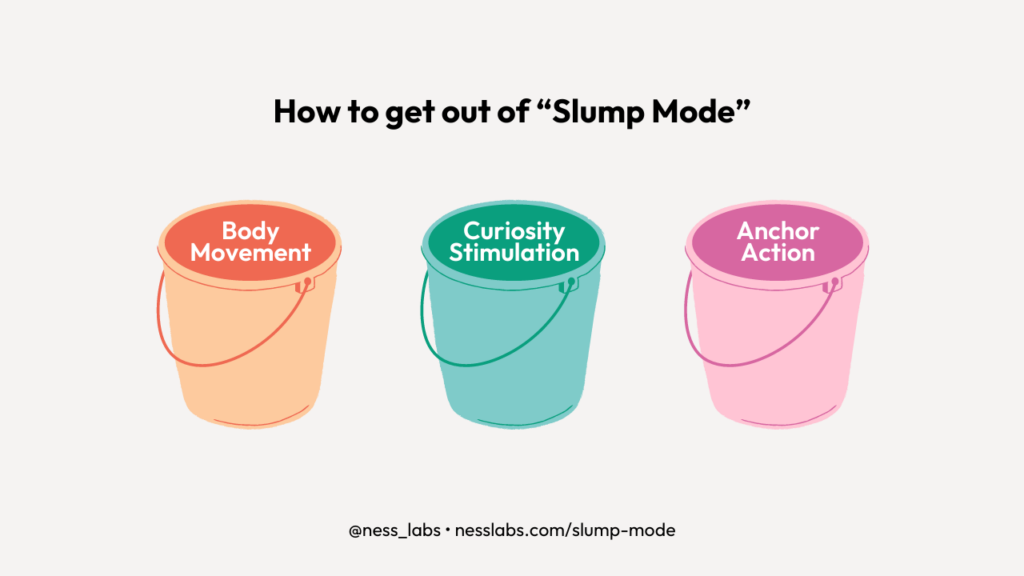Following a recent essay by Paul Graham, everyone has been talking about Founder Mode (running the business with a hands-on approach at all levels) versus Manager Mode (delegating responsibilities to direct reports). The former is motivated by a deep personal connection to the mission of the company, the latter by the need for structured operational processes as the organization grows.
There’s lots of debate around the best way to do stuff—what’s most efficient, scalable, and sustainable. But what about when you don’t feel like doing anything… When you’re in Slump Mode?
Even if you love your projects and the people you work with, whether teammates or clients, you’ll inevitably face one of those mornings when, really, the couch feels much more appealing than your computer. Let’s have a look at what’s going on and how you can get out of that slump.
The Science of Slump Mode
The first and most important step is to understand that it’s completely normal to wake up some morning with zero motivation. There are many psychological and biological factors at play that may create this sense of lethargy.
- Circadian rhythm disruptions: Our internal body clock controls sleep-wake cycles. Disruptions from poor sleep quality, irregular sleep schedules, or stress can cause grogginess and low motivation in the morning.
- Stress response: Cortisol, a hormone tied to the body’s stress response, peaks in the morning to help wake us up. However, chronic stress or burnout can cause dysregulation, leading to feelings of exhaustion and reduced drive.
- Dopamine depletion: Dopamine is a key neurotransmitter for motivation and reward. When levels are low, it can result in a sense of apathy or lack of enthusiasm for your work, even if you rationally find it interesting.
- Decision fatigue: Facing overwhelming to-do lists can deplete mental energy. This can lead to a slump where the brain seeks to avoid tasks, defaulting to inactivity as a way to conserve energy.
- Emotional exhaustion: Emotional demands from work, relationships, or personal challenges can drain your psychological resources. Waking up feeling emotionally worn out can manifest as lack of motivation to start the day.
The worst thing you can do when in slump mode is to force yourself to power through. You might be able to do it that one time, but you’d be ignoring all the signals your body is trying to send you, and that little lack of motivation might turn into full-blown burnout.
Instead, you need to design a simple “Slump Mode Protocol” for yourself that you can run automatically whenever you feel like doing nothing.
The Slump Mode Protocol
Designing a personalized protocol to get out of slump mode is an opportunity to be the scientist of your own life by designing a system that works just for you. The idea is to follow three simple steps to regain energy and focus: body movement, curiosity stimulation, and anchor action:

- Body movement. Physical movement is a powerful way to break out of a slump. Exercise releases endorphins, the body’s natural mood lifters, and increases blood flow to the brain, improving focus and alertness. Even small movements can help reset your physical state. Go for a walk, dance in your living room, stretch, do yoga, or consider some light cardio like jumping jacks.
- Curiosity stimulation. When you engage in something that piques your curiosity, it shifts your brain out of autopilot and into a mode of exploration. Stimulating curiosity refreshes your mental state, helping you feel more intellectually energized. Read or listen to something interesting, have a chat with a colleague, or browse through something creative.
- Anchor action. When you’re in a slump, it can feel overwhelming to tackle everything on your to-do list. Instead of trying to do it all, ask yourself: “If I did nothing else, what would make today feel like a good day?” This doesn’t have to be a work task. Sometimes, doing the laundry or some admin can get us back into the groove by creating a sense of accomplishment.
You can remember the three steps with the following mnemonic: “Be Curious and Act.” First, just be in your body; then stimulate your curiosity; and finally, choose one action to focus on.
Think of these as three buckets where you can choose what to put in each. Everyone is unique, and by experimenting with different options you can tailor an approach that best helps you reset and re-engage when motivation is low.
By understanding the factors behind slump mode and using this simple, customizable protocol, you can now approach your low-energy days in a much gentler way so you can reset and regain momentum.
Experiment with what works best for you, and remember—it’s completely natural to sometimes wake up and feel this way. Loving your job doesn’t shield you from the effects of your body’s natural energy cycles.
